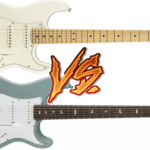Floyd Rose systems are the dream of many players.
They allow you to do extreme pitch manipulation with the whammy bar and still stay in tune as if nothing ever happened.
For some, that’s quite magical.
However, that rigorous tuning stability comes in hand with the added difficulty of deviating from the chosen tuning once the system is set up.
Many modern players that usually switch between standard and dropped tunings find this limitation a real hassle.
But is it a real limitation?
Can you drop tune a guitar with a Floyd Rose?
Here’s a short answer
Drop tuning a guitar with a Floyd Rose bridge will require a 10-minute adjustment of the whole system. Not doing this setup will cause all the other strings to fall out of tune, and the bridge to recede slightly into the guitar body. So, it’s doable, but it’s not practical to change tuning often.
In this article, I will lay out all there is about shifting the tuning of your lowest string in a guitar equipped with a Floyd Rose.
After leaving this page you will have a clearer idea about what are your options for doing so, and what are the real limitations you will be facing.
Are you ready to get started?
Let’s go!
How would drop tuning affect a Floyd Rose-equipped guitar?
Floyd Rose systems are quite complex.
They work by compensating the tension exerted by the strings to the bridge with a set of springs hidden inside the body of the guitar.
When both these forces are balanced, the bridge sits (or floats) in its regular, expected position.
Matching spring and string tension is fundamental for setting up a Floyd Rose.
The thing is when you decide to drop the 6th string, let’s say to a D, you will be altering the overall tension of the strings. To be more specific, you will be lowering it.
So, the new force equation will leave the strings short in comparison with the springs.
This will result in the bridge moving to a resting position that’s not the intended one. And, of course, you will need to retune all of your other strings since they were originally tuned to a different tension equilibrium.
Do you need to set up your guitar if you want to drop-tune it?
Yes, but this is valid mostly only for Floyd Rose-equipped instruments.
Usually, dropping just the 6th string is not an issue for guitars with fixed bridges, but in this case, and because of the whole “floating” system, a setup will be needed to re-balance it.
This is probably one of the biggest drawbacks of such a complex tremolo bridge.
How to set up a Floyd Rose for drop tunings?
The process of setting up a Floyd Rose is not complicated, but it can be a bit tedious, and particularly overwhelming if you are not very fond of working on your guitar.
Thankfully there are great guides on YouTube that will take you step by step, like the following one:
As you can see, the whole ordeal takes about 10 minutes when you know what you are doing.
Can you still play without setting up your guitar after drop tuning it?
I think you could probably still play your guitar if you drop-tuned it and did not adjust the Floyd Rose.
However, it will be completely out of tune, and the bridge will be receded towards the inside of the body cavity.
If that’s playable to you, go ahead by all means.
Normally, this won’t work for most of us, and the only way around a change to a drop tuning is by adjusting the guitar accordingly.
It’s a pain in the back, but there’s no way around it with Floyd Roses.
Or is it?
Is there any way of avoiding the need to re set up your guitar when you drop-tune it?
Many players found themselves in the awkward position of wanting to play something with a different tuning than the one their Floyd Rose is set up to.
One of these players was none other than the legend, Eddie Van Halen.
His frustration led him to develop a simple but incredibly useful device called the “D-tuna”.
I think the name is self-explanatory.
The D-tuna works as a shim on the 6th string’s saddle, and by pushing or pulling it, it changes its position lowering or raising its pitch.
For this to work, the bridge can’t be completely floating, however.

Hello there, my name is Ramiro and I’ve been playing guitar for almost 20 years. I’m obsessed with everything gear-related and I thought it might be worth sharing it. From guitars, pedals, amps, and synths to studio gear and production tips, I hope you find what I post here useful, and I’ll try my best to keep it entertaining also.





